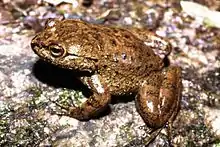Megaelosia
Megaelosia is a genus of frogs in the family Hylodidae.[1][2] The genus is endemic to the Serra do Mar and Serra da Mantiqueira in southeastern Brazil. These frogs are sometimes known as the big-tooth frogs.[1]
| Megaelosia | |
|---|---|
 | |
| Megaelosia boticariana | |
| Scientific classification | |
| Kingdom: | Animalia |
| Phylum: | Chordata |
| Class: | Amphibia |
| Order: | Anura |
| Family: | Hylodidae |
| Genus: | Megaelosia Miranda-Ribeiro, 1923 |
| Type species | |
| Megaelosia bufonia Miranda-Ribeiro, 1923 | |
| Diversity | |
| 7 species (see text) | |
Megaelosia are rheophilic: they are associated with fast-flowing rivers. They are difficult to collect because they are easily disturbed and plunge into the torrential waters. Their teeth of are fanglike and larger than those of their close relatives. This might be associated with their predatory habits: at least two species are known prey on small vertebrates as well as invertebrates.[3] The tadpoles are aquatic. Megaelosia are relatively large frogs, with adults attaining lengths up to 120 mm (4.7 in) in snout–vent length.[4]
Species
There are seven species:[1][2]
- Megaelosia apuana Pombal, Prado, and Canedo, 2003
- Megaelosia bocainensis Giaretta, Bokermann, and Haddad, 1993
- Megaelosia boticariana Giaretta and Aguiar, 1998
- Megaelosia goeldii (Baumann, 1912)
- Megaelosia jordanensis (Heyer, 1983)
- Megaelosia lutzae Izecksohn and Gouvêa, 1987
- Megaelosia massarti (De Witte, 1930)
References
- Frost, Darrel R. (2015). "Megaelosia Miranda-Ribeiro, 1923". Amphibian Species of the World: an Online Reference. Version 6.0. American Museum of Natural History. Retrieved 29 April 2015.
- "Hylodidae". AmphibiaWeb: Information on amphibian biology and conservation. [web application]. Berkeley, California: AmphibiaWeb. 2015. Retrieved 29 April 2015.
- Giaretta, Ariovaldo A.; Bokermann, Werner C. A.; Haddad, Celio F. B. (1993). "A review of the genus Megaelosia (Anura: Leptodactylidae) with a description of a new species". Journal of Herpetology. 27 (3): 276–285. doi:10.2307/1565148. JSTOR 1565148.
- Vitt, Laurie J.; Caldwell, Janalee P. (2014). Herpetology: An Introductory Biology of Amphibians and Reptiles (4th ed.). Academic Press. p. 486.